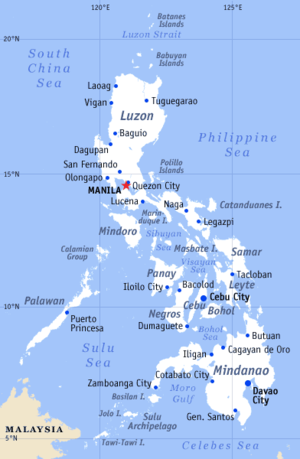Benutzer:FvSS 18-19 G8a Schüler20: Unterschied zwischen den Versionen
Keine Bearbeitungszusammenfassung |
Keine Bearbeitungszusammenfassung |
||
| Zeile 1: | Zeile 1: | ||
[[Datei:Ph general map.png|mini]] | The climate change in the Philippines will potentially impact agriculture,water,energy[[Datei:Ph general map.png|mini]] | ||
coastal ecosystems,infrastructures/services and human health.The brief includes an overview and climate summary of the philippines,as well as projected climate change.The philippines is highly vulnerable to the impact of climate change,including the sea level rise,increased frequency of extreme weather events,rising temperatures and extreme rainfalls.This is due to its high exposures to natural hazards(cyclones,landslide,floods and droughts)dependence on climate-sensitive natural resources and vast coastlines where all major cities and the majority of the populations reside.The Philippines lies in the world's most cyclones-prone region,averaging 19-20 cyclones each year,of which 7-9 make landfall and the sea level in the Philippines rising faster than the global average.A rich yet increasingly depleted natural and marine resources base supports livelihoods through fisheries,agricultures,foresty,energy,mining and tourism and provides critical ecosystem services such as shoreline protection,floods control, soil stability and habitats for biodiversity. | |||
Version vom 27. Mai 2019, 15:35 Uhr
The climate change in the Philippines will potentially impact agriculture,water,energy
coastal ecosystems,infrastructures/services and human health.The brief includes an overview and climate summary of the philippines,as well as projected climate change.The philippines is highly vulnerable to the impact of climate change,including the sea level rise,increased frequency of extreme weather events,rising temperatures and extreme rainfalls.This is due to its high exposures to natural hazards(cyclones,landslide,floods and droughts)dependence on climate-sensitive natural resources and vast coastlines where all major cities and the majority of the populations reside.The Philippines lies in the world's most cyclones-prone region,averaging 19-20 cyclones each year,of which 7-9 make landfall and the sea level in the Philippines rising faster than the global average.A rich yet increasingly depleted natural and marine resources base supports livelihoods through fisheries,agricultures,foresty,energy,mining and tourism and provides critical ecosystem services such as shoreline protection,floods control, soil stability and habitats for biodiversity.




